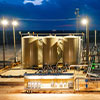
Market Fundamentals
Capex Cuts May Lead To Supply Shortage
LONDON–The world’s operators will drill 73 percent fewer wells in 2016 than they did in 2014, while discovered oil volumes are expected to hit a decade low, Richmond Energy Partners predicts. The group’s seventh annual State of Exploration report benchmarks the performance of international oil and gas exploration. It is one of two studies laying out possible oil and gas scenarios.
A study from the Deloitte Center for Energy Solutions warns the global upstream industry faces a $2 trillion funding gap, with diminished capital spending threatening future reserves and production. The study, Short of Capital? Risk of Underinvestment in Oil and Gas is Amplified by Competing Cash Priorities, says the industry has cut its capital spending by 50 percent in 2015 and 2016.
“Industry has responded to the downturn by slashing exploration budgets by more than 70 percent, on average,” says Keith Myers, managing director for Richmond. “Sustained oil prices above $60 a barrel are needed to stimulate exploration. The geology economic to explore at $40 a barrel actually is quite limited.”
Richmond says its report is based on an analysis of more than 1,100 exploration wells and covers $49 billion of exploration drilling since 2010.
“It takes significant capital for the industry to just remain flat,” observes John England, Deloitte LLP vice chairman, and U.S. and Americas oil and gas leader. “Actual and announced capital expenditure cuts suggest that even remaining flat could be a challenge, let alone meeting any expected growth. The industry’s capex cycle will take time to stabilize and recover. Even in a weak demand and reduced costs outlook, we estimate the global upstream industry will need to spend a minimum of $3 trillion during 2016-20 to ensure its long-term sustainability.”
Frontier Programs
The Richmond report says commercial oil discoveries fell to an eight-year low in 2015, as plays matured and frontier programs failed to replenish prolific emerging oil plays. It indicates $17 billion of frontier drilling spent over five years generated 16 new commercial plays in 12 basins, for a commercial success rate of 8 percent.
Other highlights from the report include:
- $60 a barrel is a critical oil price floor to sustain offshore exploration. Below this level, even allowing for cost reductions, the number of commercial discoveries decreases such that at $40/bbl, only 40 percent of the discoveries potentially commercial at $60/bbl are economically viable. Of the 57 offshore oil plays that delivered discoveries in the study period, only 12 were potentially commercial at $40/bbl.
- Fewer than half of the 40 study group companies replaced production through conventional exploration over five years, although 25 percent made discoveries that transformed their resource bases. This leaves the door open to more merger and acquisition activity.
- Finding costs fell in 2015 because of some large deepwater discoveries in Mauritania and Egypt, but oil-finding costs reached an eight-year high of $4.30 a barrel.
- Exploration drilling completions in 2016 are expected to be 57 percent below 2015 levels and down 73 percent from the 2014 preprice crash levels. A diminished frontier campaign continues, with 19 wells planned and a continued focus on the Atlantic Margins.
“Industry has learned some hard lessons from the downturn,” Myers says. “Many companies overcommitted to drilling wells in order to access acreage. The State of Exploration report makes clear that the increased drilling did not lead to more success, and that the risks of certain plays were systematically underestimated.”
While exploration strategy is being reset across the industry, Myers says Richmond sees a real opportunity for companies, predicting a rapid transition from the financial crisis to a growth crisis once oil prices recover. He adds that companies that maintain investments and upgrade their portfolios through this cycle will be the ones to prosper.
The State of Exploration report is available through the Richmond Energy Partners website at www.richmondep.com/reports.
Improving Balance Sheets
The Deloitte study says overcoming a $3 trillion capex shortfall is not the only challenge facing oil and gas producers. Short of Capital points out that upstream companies also have to shore up balance sheets, service upcoming debt maturities, and maintain already reduced dividend payouts. Over the next five years, $590 billion of the industry’s debt is maturing, Deloitte says, and shareholders will expect $600 billion in already reduced payouts.
According to the study, that takes total cash-flow obligations of integrated oil companies, listed national oil companies, and independent exploration and production companies up to more than $4 trillion from 2016 to 2020.
“Such huge outflows raise a question as to whether upstream business will generate enough cash, and where capex will figure in the priority order of companies,” assesses Andrew Slaughter, executive director at the Deloitte Center for Energy Solutions. “When we annualize operating cash flows of all three company sets in 2015 for the next five years, assuming a $55/bbl average oil price, we see a total funding gap of up to $2 trillion from operations.”
Any unforeseen oil price increases would theoretically help bridge the capital gap. However, the study says in practice, upstream costs tend to track with the commodity recovery, which could prevent free cash flow from rising with prices. Similarly, it says, any reduction in exploration or development spending could reduce the gap, but this would leave the world unprepared for black swan events, or come at the expense of heightened supply risks and price volatility.
The report also shows that while sustaining production likely will be a challenge for the industry by the end of the decade, the bigger concern is the quantity and quality of reserves at which the world enters the next decade. Dipping into easy and cheap resources outside the Organization of Petroleum Exporting Countries could help sustain production without burdening cash flows in the near term, but Deloitte warns this would leave high-cost and/or risker barrels for the future.
For natural gas, it says the concern for a reserves shortfall is bigger than oil, since the commodity has yet to see its best years of demand growth in the developing world.
The Deloitte study is available at https://www2.deloitte.com/content/dam/Deloitte/us/Documents/energy-resources/us-er-short-of-capital.pdf.
For other great articles about exploration, drilling, completions and production, subscribe to The American Oil & Gas Reporter and bookmark www.aogr.com.














